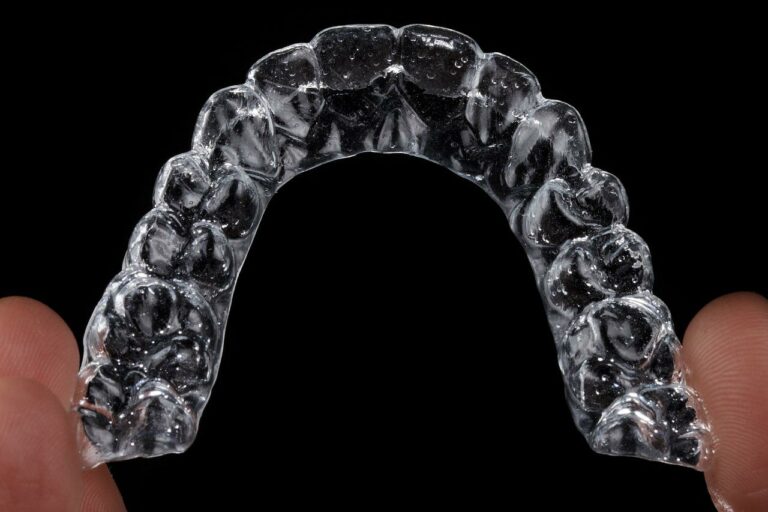Invisalign vs Braces: Which Is Right for You?
When it comes to straightening your smile, you’ve got options. For most people it’s going to come down to: Braces vs Invisalign. Both are proven methods to correct alignment issues, but they differ in appearance, comfort, cost, and treatment process. Choosing between braces or Invisalign depends on your lifestyle, budget, and the complexity of your dental needs.
Let’s take a closer look at the key differences between braces and Invisalign, how each works, and how to decide which treatment might be right for you.
How Does Invisalign Work?
Invisalign uses a series of custom-made, clear plastic aligners that gently shift your teeth into place over time. Your dentist or orthodontist designs a 3D digital treatment plan, mapping the exact movements your teeth need to make. You’ll receive several sets of aligners, each worn for about one to two weeks before moving to the next stage.
Each aligner applies targeted pressure to specific teeth, gradually achieving the desired alignment. Since the trays are removable and virtually invisible, Invisalign offers a discreet alternative to traditional braces. You can take them out when eating, brushing, or for special occasions—just remember, they must be worn 20–22 hours per day to stay effective.
Invisalign is ideal for mild to moderate crowding, spacing, and bite issues such as overbites or underbites.
How Traditional Braces Work
Traditional braces use metal or ceramic brackets bonded to the teeth and connected with a wire. The orthodontist periodically tightens the wire, guiding the teeth into proper alignment. While braces are more noticeable, they’re also more powerful in treating complex cases.
Braces are fixed in place, meaning you don’t have to remember to wear them but that doesn’t mean they’re maintenance-free. You do need to keep up with regular adjustments and practice meticulous oral hygiene.
Braces are ideal for severe misalignment, rotated teeth, or complex bite corrections that require more control. They also work well for patients that want a hands-off
Invisalign vs Braces: Key Differences
Here’s how Invisalign and braces stack up across several important factors:

The Benefits of Invisalign
- Discreet Appearance: Invisalign aligners are virtually invisible, making them an appealing choice for adults and teens who prefer a subtle treatment.
- Comfortable Fit: Smooth, BPA-free plastic aligners reduce irritation to gums and cheeks.
- Removable Convenience: You can take them out for meals, meetings, or photos.
- Easier Hygiene: Since aligners can be removed, brushing and flossing are much simpler than with braces.
- Predictable Results: Advanced 3D planning technology lets you see a digital preview of your future smile before treatment begins.
Invisalign requires more discipline than traditional braces. Forgetting to wear your aligners consistently can delay progress and even affect final results.
The Benefits of Braces
- Effective for All Cases: From minor gaps to severe crowding, braces can treat a wide range of alignment problems.
- No User Error: Because they’re fixed, braces are always working. There’s no risk of forgetting to wear them.
- Multiple Options Available: Traditional metal braces, ceramic (tooth-colored) braces, and even lingual braces (behind the teeth) provide aesthetic choices.
- Precise Adjustments: Orthodontists can fine-tune your alignment with great accuracy.
Braces can cause a little more irritation in your mouth, especially after adjustments. In addition, they require avoiding certain foods that may damage brackets or wires. In the case that a bracket does come off the tooth, it requires a quick trip to the orthodontist’s office for a repair.
Braces or Invisalign: Which Should You Choose?
When deciding between braces or Invisalign, consider the following:
- Complexity of your case: If you have significant bite issues or complex tooth movements, braces might be more effective. For mild to moderate alignment issues, Invisalign can deliver excellent results.
- Lifestyle and discipline: Invisalign is removable, which means freedom—but also responsibility. If you think you might forget to wear your aligners, braces provide a “set it and forget it” solution.
- Aesthetic preferences: If you want a nearly invisible treatment, Invisalign is the clear winner.
- Budget and insurance: The two treatments are often comparable in cost, but coverage varies. Check with your orthodontist and insurance provider to see which option fits your budget.
- Age considerations: Invisalign is popular among adults and image-conscious teens, while younger patients might benefit more from the structure and reliability of braces.
Combining Technology and Expertise
Technology has made it possible for modern orthodontics to truly provide customized care. Many orthodontic practices use digital scans, 3D imaging, and advanced materials to make both Invisalign and braces more efficient and comfortable than ever before.
Your orthodontist will evaluate your bite, tooth movement, and overall oral health before recommending the best option. Sometimes, a combination approach (using braces first and Invisalign later for fine-tuning) can deliver the best results.
The Bottom Line: Invisalign vs Braces
When it comes to Invisalign vs braces, there’s no one-size-fits-all answer. Both treatments are effective, safe, and capable of transforming your smile. The right choice depends on your individual needs, goals, and lifestyle.
If you want a discreet, flexible, and comfortable treatment—and you’re committed to wearing your aligners as directed—Invisalign might be the perfect fit. If you need more complex adjustments or prefer not to worry about daily compliance, braces remain a tried-and-true solution.
The best next step? Schedule a consultation with your Las Vegas orthodontist. They’ll evaluate your smile, explain how Invisalign works, and help you determine whether braces or Invisalign is the best choice to achieve the healthy, confident smile you deserve.







